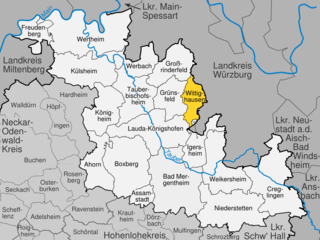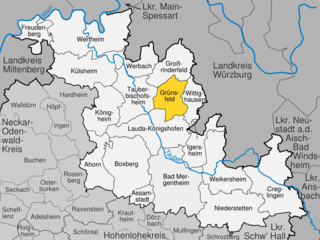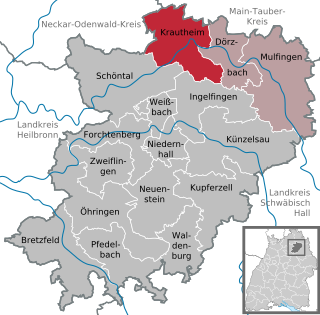Landkreis Heilbronn is a Landkreis (district) in the north of Baden-Württemberg, Germany. Neighboring districts are Neckar-Odenwald, Hohenlohe, Schwäbisch Hall, Rems-Murr, Ludwigsburg, Enz, Karlsruhe and Rhein-Neckar. In the centre of it is the free-city of Heilbronn, which is its own separate administrative area.
Neckar-Odenwald-Kreis is a Landkreis (district) in the north of Baden-Württemberg, Germany. Neighboring districts are Main-Tauber-Kreis, Hohenlohe-Kreis, Heilbronn, Rhein-Neckar-Kreis, Odenwaldkreis (Hesse) and Landkreis Miltenberg (Bavaria). The district is part of the Rhine-Neckar Metropolitan Region.
The Hohenlohe is a Landkreis (district) in the north of Baden-Württemberg, Germany. Neighboring districts are Neckar-Odenwald, Main-Tauber, Schwäbisch Hall and Heilbronn.
Schwäbisch Hall is a Landkreis (district) in the northeast of Baden-Württemberg, Germany. Neighboring districts are Main-Tauber, the Bavarian district Ansbach, Ostalbkreis, Rems-Murr, and Hohenlohe.

Bad Mergentheim is a town in the Main-Tauber-Kreis district in the German state of Baden-Württemberg. It has a population of around 23,000. An officially recognized spa town since 1926, Bad Mergentheim is also known as the headquarters of the Teutonic Order from 1526 until 1809.

Wertheim is a town in southwestern Germany, in the state of Baden-Württemberg with a population of around 23,400. It is located on the confluence of the rivers Tauber and Main. Wertheim is best known for its landmark castle and medieval town centre.

Tauberbischofsheim is a German town in the north-east of Baden-Württemberg on the river Tauber with a population of about 13,200. It is the capital of the Main-Tauber district. It is a popular tourist destination due to its numerous historical buildings, including substantial remains of the medieval town fortifications.

Wittighausen is a municipality in the district of Main-Tauber in northeast Baden-Württemberg, Germany. It consists of the villages of Oberwittighausen, Poppenhausen, Unterwittighausen, and Vilchband.

Freudenberg is a town and a municipality in the district Main-Tauber-Kreis, in Baden-Württemberg, Germany. It is situated on the river Main and has a population around 3,700.

Niederstetten is a town and a municipality in the Main-Tauber district, in Baden-Württemberg, Germany. It is situated 14 km southeast of Bad Mergentheim, and 19 km west of Rothenburg ob der Tauber.

Lauda-Königshofen is a town in the Main-Tauber district in Baden-Württemberg, Germany. It is situated on the river Tauber, 7 km southeast of Tauberbischofsheim, and 30 km southwest of Würzburg. Most of the roughly 300 houses in the traditional village of Königshofen date to between the 16th century and mid-19th century, and it is known for the 500+ year-old Königshöfer Messe, an annual festival that attracts 150,000 people over the 10-day festival. Lauda station is at a junction of the Franconia Railway and the Tauber Valley Railway.

Boxberg is a town in the Main-Tauber district, in Baden-Württemberg, Germany. It is situated 16 km south of Tauberbischofsheim. Population is 6718 people in 2020.

Grünsfeld is a town and a municipality in the Main-Tauber district, in Baden-Württemberg, Germany. It is situated 6 km east of Tauberbischofsheim, and 25 km southwest of Würzburg. It consists of the villages Grünsfeld, Grünsfeldhausen, Krensheim, Kützbrunn, Paimar, and Zimmern.

Krautheim is a town in the Hohenlohe district of Baden-Württemberg, in south central Germany. It is situated on the river Jagst, 12 km (8 mi) northwest of Künzelsau, and 16 km (10 mi) southwest of Bad Mergentheim. The town lies in the border area between the Baden and Württemberg regions. Records from the year 1096 mention the area as "Crutheim", but the modern incorporation was approved during 1972–73.

Külsheim is a town in the Main-Tauber district, in Baden-Württemberg, Germany. It is situated 12 km northwest of Tauberbischofsheim, and 10 km south of Wertheim am Main.

Osterburken is a town in the Neckar-Odenwald district, in Baden-Württemberg, Germany. It is situated 28 km southwest of Tauberbischofsheim, 50 km northeast of Heilbronn, 90 km east of Heidelberg, 60 km southwest of Würzburg and 30 km east of Mosbach. The S1 S-Bahn line of VRN public transport service operates between Homburg (Saarland) and Osterburken, hence the train station here is used frequently to transfer to and from other trains.

Weikersheim is a town in the Main-Tauber district of Baden-Württemberg, Germany.

Gaiberg is a municipality in the Rhein-Neckar-Kreis of Baden-Württemberg.

Werbach is a municipality in the district of Main-Tauber in Baden-Württemberg in Germany.

The region of Tauber Franconia is a part of the region of Franconia, most of which lies in the German state of Baden-Württemberg. Tauber Franconia is almost coextensive with the county of Main-Tauber-Kreis, which is bisected by the River Tauber, but a small part also belongs to the Bavarian county of Würzburg. The upper reaches of the Tauber flow through 13 villages in seven municipalities in the county of Ansbach, including the well known town of Rothenburg ob der Tauber. The source of the Tauber is in the county of Schwäbisch Hall. The most important towns in Tauber Franconia are Wertheim am Main, Tauberbischofsheim, Lauda-Königshofen and Bad Mergentheim on the Baden-Württemberg side, and Röttingen on the Bavarian side.




















